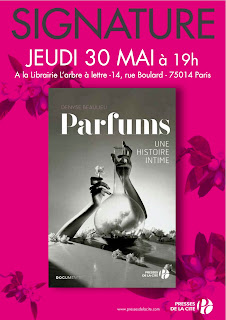It should come as no surprise that the owners of Aedes de Venustas, Robert Gerstner and Karl Bradl, both hail from the land that gave
us the Asam brothers and Ludwig II. No
one did Rococo -- a mid-18th century style that’s all about curves,
trompe-l’oeil, playfulness and general, glorious, Catholic over-the-top-ness –
better than the Bavarians. Thus, the holy shrine of New York perfume
aficionados is a lush cross of the Rococo and the Romantic; a wormhole
tunneling back from the West Village into Lola Montès’s boudoir.
But though the boutique’s aesthetics is reprised in
the packaging of the Aedes perfume brand, the scents themselves are made of
sterner stuff. Bertrand Duchaufour’s rhubarb-skewered cloud of incense in Aedes de Venustas Eau de Parfum managed to
feel both archaic and dementedly modern – he called it his “crazy accord”. Ralf Schwieger’s Iris Nazarena, while seemingly more subdued, inhabits the same
time-warp.
The scent’s inspiration and namesake, depicted above,
could have been plucked from the hothouses of Huysmans’s decadent Des
Esseintes: a somber iris tugged between morphing into an orchid and a
trompe-l’oeil insect. It grows on the ancient hills surrounding Nazareth, from
which it draws its name, Iris nazarena.
There’s still a German connection going on though, since its scientific name is
Iris bismarckiana, bestowed in the
late 19th century by the botanist Sprenger (and likely a tribute to
Chancellor Otto von Bismarck)… And of course, between the creative director’s
native Bavaria and the perfumer’s homeland Westphalia, the Prussian-inspired
nomenclature fits in neatly. Though you’d be hard-pressed to find anything
Germanic in the scent itself, birthed in New York by a Grasse-based company
(Mane)…
Considering its muse, the scent could have been called
Iris Gris. But for Ralf Schwieger,
the first hurdle was steering clear of the N°19
template: he clears it by using a different type of greenness: star anise spans
the spectrum from day-glo green to burnt umber liquorish. Ambrette shoots its
limpid, iced-vodka light into the blend. Schwieger has worked in layers of pastel
and charcoal strokes, the iris’s powdery texture blurring into a haze of
incense over a petal-thin suede base. The effect is a texture both delicate and
tough, flecked with the burnt smells of clove and oud, rooted in earth and flint.
There is already a consistency to Bradl and Gerstner’s
olfactive choices, not only because incense is the thread that will run through
the collection, but also because the way notes are put forward in bold, wide
strokes seems to express a house style. It’ll be interesting to see whether
their projects with other perfumers display that same consistency. But it seems
that Aedes de Venustas is shaping up to be a real voice in niche perfumery.
Aedes de Venustas have kindly offered five samples for
my readers. Just drop a comment to participate.





